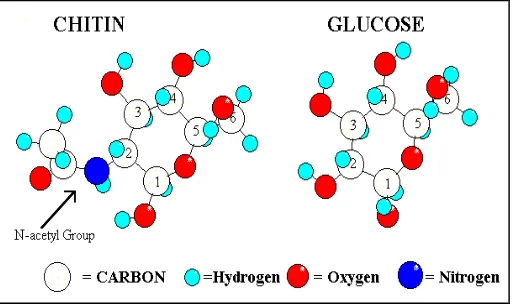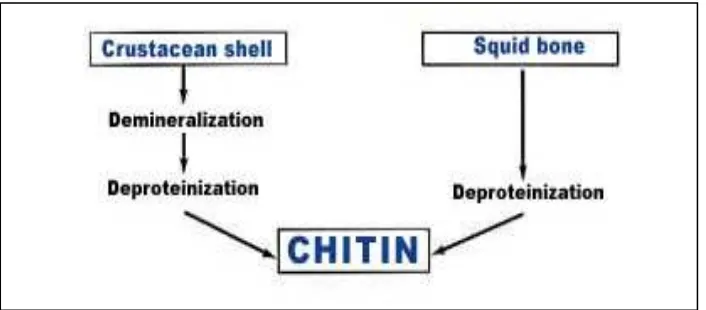STUDY OF THE THERMAL PROPERTIES OF
CHITOSAN FILM
HARLINA BINTI NGAH
UNIVERSITI TEKNIKAL MALAYSIA MELAKA
STUDY OF THERMAL PROPERTIES OF CHITOSAN FILM
This report submitted in accordance with the requirement of the Universiti Teknikal Malaysia Melaka (UteM) for the Bachelor Degree of Manufacturing Engineering
(Engineering Materials) with Honours.
by
HARLINA BINTI NGAH
ABSTRACT
ABSTRAK
DEDICATION
To my beloved parents who have always encouraged me to “Go for it!” and
ACKNOWLEDGEMENT
Assalamualaikum WBT,
First and foremost, I would like to express my deepest sense of gratitude to my supervisor Encik Fairuz bin Dimin for his patient guidance, encouragement, detailed and constructive comments and excellent advice throughout this study. His understanding, encouraging and personal guidance have provided a good basis for the present report.
My sincere gratitude and warmest thanks also goes to Encik Mohd Haizal bin Mohd Husin. His wide knowledge, constructive criticism, kind support and guidance have been of great value in this study. I wish to express my warm and sincere thanks to the technicians which are Encik Ismail and also Encik Salman for their essential assistance during finishing this project.
I am bound to the Faculty of Manufacturing Engineering of UTeM and especially to Encik Sivarao a/l Subramonian as the PSM Coordinator for their hard works and stimulating support. For all my fellow friends in UTeM especially from Bachelor of Manufacturing (Engineering Materials), I want to thank them for all their endless help, support, interest and valuable hints.
TABLE OF CONTENTS
List of Abbreviations, Symbols & Nomenclature xii
2.2.4.1 Film Forming Method 18
2.2.5 Applications of Chitosan 19
2.3. Infrared Spectroscopy (IR) 21
2.3.1 Fourier Transform Infrared Spectrometer (FT-iR) 23
2.3.1.1 Michelson Interferometers 24
3.4.1 Fourier Transform Infrared Spectrometer (FT-iR) 36 3.4.2 Direct Current (DC) Conductivity Measurement Test 37
3.5. Experimental Procedures 38
3.5.1 Sample Preparation 38
3.5.2 FT-iR Testing 40
3.5.3 Direct Current (DC) Conductivity Measurement Test 41
3.6. Data Analysis 43
3.6.1 FT-iR Spectrum 43
4. RESULTS AND DISCUSSION 46
4.1. Introduction 46
4.2. Film Samples 46
4.3. Fourier Transform Infrared Spectrometer (FT-iR) Analysis 49
4.3.1 Pure Chitosan 49
4.4 Direct Current (DC) Conductivity Measurement Test Analysis 61
4.4.1 Plot of Log σ vs. 1/T (1/K) 61
5. CONCLUSIONS AND RECOMMENDATIONS 69
LIST OF TABLES
2.1 Applications of Chitosan 19
2.2 Comparison of Conventional and FTIR Spectroscopy 24
2.3 Applications of Zeolites 29
3.1 Current Reading for Pure Chitosan 44
4.1 Peak intensity at 1040 cm-1, 3610 cm-1 and 1661 cm-1 56 4.2 Comparison of pure chitosan and chitosan-zeolite 60
LIST OF FIGURES
3.10 A homogenous pure chitosan solution after 1 hour been stirred 38 3.11 5 ml solution was let dried in 50 mm Petri dish 39 3.12 Chitosan film on a filter paper for drying purpose 39 3.13 Circular shape of 1.8 cm diameter was drawn on each sample 42 3.14 Silver conductive paint was applied to the circular shape 42 3.15 Sample was kept under pressure inside the furnace 423.16 An example of individual FT-iR spectrum 43
3.17 An example of overlay FT-iR spectrum 44
4.1 Pure chitosan 47 4.10 FT-iR spectrum of chitosan-zeolite film of 1.0g zeolite 53
4.11 FT-iR spectrum overlay of all samples 54
LIST OF ABBREVATIONS, SYMBOLS &
DSC – Differential Scanning Calorimetry
DTA – Differential Thermal Analysis
FT-iR – Fourier Transform Infrared Spectrometer
g – Gram
g/cm3 – Gram per cubic centimeters
g/mol – Gram per mol
GlcN – Glucosamine
GlcNAc – N-acetylglucosamine
H – Hydrogen
HCl – Hydrocloric Acid
IR – Infrared Spectroscopy
K – Kelvin
kDa – kilo Daltons
kg – Kilogram
KOH – Potassium Hydroxide
MCC – Microcrystalline Chitin
PEMFC – Proton Exchange Membrane Fuel Cell
pH – Potential of Hydrogen
psi – Pound per square inch
rpm – Rotations per minute
SEM – Scanning Electron Microscopy
Tc – Crystallization temperature
Tg – Glass transition temperature
1
CHAPTER 1
INTRODUCTION
1.1 Background of Study
Chitosan, poly-(1-4)-ß-glucosoamine, constitutes a valuable raw material in the production of film, fibres, beads, sponges, microcrystalline chitosan and fibrids. Chitosan is a carbohydrate polymer that can be derived from crustacean seafood wastes such as shells of crabs, shrimps and crawfish. Chitosan has a wide range of applications in diverse fields ranging from medical sutures and seed coatings to dietary supplements and coagulants for waste treatment. Presently, chitosan is widely used in medicine, veterinary, husbandry, cosmetics and the food industry (Nadarajah, 2005).
Thermal properties of chitosans and their functionalities are affected by their sources (Rhazi et al., 2004) and the methods employed to extract them (Brine et al., 1981). Furthermore, many characteristics of the chitosan (molecular weight, its polydispersity, the purity) are greatly dependant on the method, the equipment used and also of the source of the shells. It is therefore, crucial to control precisely methods of production of the chitosan to obtain the exact characteristics needed for end use application of the product (Beaulieu, 2005). Hence, different thermal properties and functionalities can be expected from chitosans derived from shrimp shell by different composition.
2
biomedical materials and there have been many relative reports such as artificial skin and artificial kidney.
In addition, the intra-structure of macromolecular compound is very complex, and exist crystal phase region and non-crystal phase region. The crystallinity is the weight percent of crystal phase region, and the stable physicochemical properties of chitosan should be ascribed to its high crystallinity, which increases with the de-acetyl degree increasing (Miranda, 2004).
The properties of chitosan can be determined by using Fourier Transform Infrared Spectroscopy (FT-iR). FT-iR is an analytical technique used to identify organic (and in some cases inorganic) materials. This technique measures the absorption of various infrared light wavelengths by the material of interest. These infrared absorption bands identify specific molecular components and structures. It can be applied to the analysis of solids, liquids, and gasses (Bosscher, 2001).
The term Fourier Transform Infrared Spectroscopy refers to a fairly recent development in the manner in which the data is collected and converted from an interference pattern to a spectrum. Samples for FT-iR can be prepared in a number of ways. Alternatively, solid samples can be dissolved in a solvent such as methylene chloride, and the solution placed onto a single salt plate. The solvent is then evaporated off, leaving a thin film of the original material on the plate. This is called a cast film, and is frequently used for polymer identification (Stuart, 2005).
Other than that, the Direct Current (DC) Conductivity Measurement also can exhibit the thermal properties and the ability of the chitosan to conduct the ion. Most polymers are basically have very low electrical conductivities. Thus, under normal electrical fields the measured currents are usually very low. DC conductivity may be attributed to electrons or ions or both. Usually in naturally occurring polymers like chitosan studied here, the dominant conduction mechanism is ionic, the electronic conductivity being very small and very difficult to measure accurately.
3
conductivity studies can give an indication of the charge transfer mechanism involved. Measurements of DC conductivity are usually done while varying the temperature and this can provide further information on the nature of the transport mechanism, or the temperature-dependent characteristics of the conductivity.
1.2Problem Statement
Proton exchange membrane fuel cell (PEMFC) is a type of fuel cell in which polymer membrane is used as electrolyte. Currently, the most popular membrane used in research and industry comprises of tetrafluorethylene that make it very expensive and hazardous to the environment. The interest of using the chitosan is because of its biodegradable properties and else, it can be easily got as it is just a waste material. Zeolites are hydrated alumino-silicates with symmetrically stacked alumina and silica tetrahedral which result in an open and stable three dimensional honey comb structure with a negative charge. This net negative charge makes zeolite posses high cation exchange capacity and motivates the interest in chitosan-zeolite composite membrane.
4
1.3Objectives
The objectives of this project are:
(a) To characterize the physical and thermal properties of chitosan film via analytical and universal testing instruments such Fourier Transform Infrared Spectroscopy (FT-iR) and Direct Current (DC) Conductivity Measurement. (b) To study the effect of the zeolite to the chitosan film and the ability of it to
conduct the electricity.
(c) To analyze the FT-iR spectrums of the chitosan film and chitosan-zeolite films.
(d) To investigate the ability of the chitosan-zeolite as a new material in the proton exchange membrane fuel cell (PEMFC).
1.4 Scope Of The Project
The scopes of the project are;
(a) Development of pure chitosan and chitosan-zeolite composites films.
(b) To study the optical properties and thermal properties of pure chitosan and chitosan-zeolite films by using FT-iR.
(c) Analysis of FT-iR spectrums of pure chitosan and chitosan-zeolite film. (d) Investigate the ability of the chitosan and chitosan-zeolite films to conduct
5
CHAPTER 2
LITERATURE REVIEW
2.1 Chitin
The basic principles of the chitin isolation are known since the beginning of 19th century (Beaulieu, 2005). Chitin was described for the first time in 1911 by Professor Henri Braconnot, who was professor of Natural History, director of the Botanical Garden and member of the Academy of Science of Nancy, France. In the pursuit of his researchers on mushroom, he treated Agaricus Volvaceus and other mushroom with diluted warm alkali and isolated chitin, possibly slightly contaminated with proteins. From the dry distillation of this product, called fungi, he obtained a liquid that, upon distillation with potassium hydroxide, yielded ammonia. He described the lack of reaction of chitin with diluted alkali solutions, the compound formed with tannin, the degradation produced by sulfuric acid, the release of acetic acid and several other reactions of chitin (Anonymous, 1998). In 1823, Odier renamed fungine as chitin (meaning tunic in Greek) almost 3 decades before the isolation of cellulose (Beaulieu, 2005).
6
Figure 2.1: Molecular structure of chitin
(Source:http://www.langara.bc.ca/biology/mario/htm.)
A polysaccharide is a polymer with long-chain carbohydrate made up of hundreds or thousands of linked simple sugars (monosaccharide) such as glucose and closely related molecules. Chitin is similar to cellulose both in chemical structure and in biological function as a structural polymer (No et al., 1995). The crystalline structure of chitin has been shown to be similar to cellulose in the arrangements of inter- and intrachain hydrogen bonding as shown in Figure 2.2 below. Like cellulose, chitin is a fiber, but it has outstanding chemical and biological properties that can be used in a large number of industrial and medical applications (Clarke et al., 2001).
Figure 2.2: The crystalline structure of chitin (Source: http://www.members.tripod.com//struc2.gif)
The increased use of chitin (and its derivates) is motivated by the fact that contrary to the petroleum derivatives, chitin is obtained from fisheries by-products, naturally renewable source, non-toxic, non-allergenic, anti-microbial and biodegradable (Peh
et al., 2000). While there is exists many extraction methods of the chitin from the
7
The crustacean waste is the most important chitin source for commercial use due to its high chitin content and ready availability.
However, chitin present in the crustacean waste is associated with proteins, minerals (mainly calcium carbonate) and lipids including pigments. Therefore, chitin purification passes through several steps which are the grinding of the shells to a uniform particle size, protein separation (deproteinization), mineral removal (demineralization) and elimination of pigments and lipids (Mahmoud et al., 2007). The proteins are removed by a treatment in a dilute solution of sodium hydroxide (1-10%) at high temperature (85-100°C). The process of demineralized is done by treating in a dilute solution of hydrochloric acid (1-10%) at room temperatures (Beaulieu, 2005). The processes involved in producing the chitin are shown in Figure 2.3 below.
Figure 2.3: Process of producing the chitin from the crustacean shell
(Source: http://www.france chitine.com/html)

